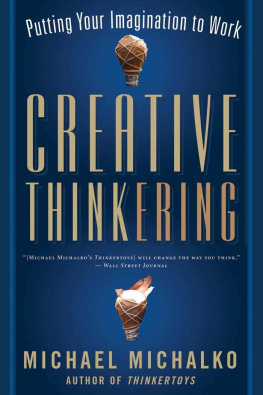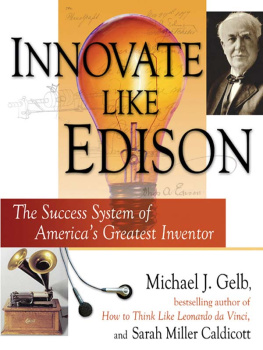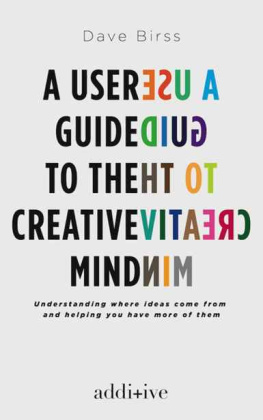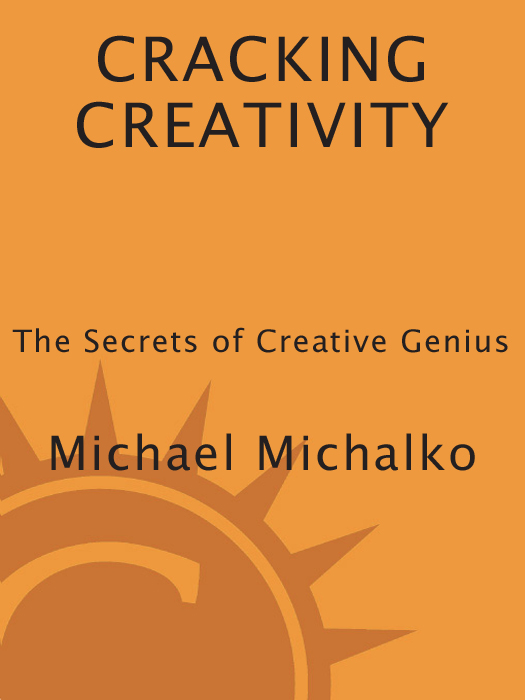Copyright 2001 by Michael Michalko
All rights reserved.
Published in the United States by Ten Speed Press, an imprint of the
Crown Publishing Group, a division of Random House, Inc., New York.
www.crownpublishing.com
www.tenspeed.com
Ten Speed Press and the Ten Speed Press colophon are registered trademarks of Random House, Inc.
Library of Congress Cataloging-in-Publication Data is on file with the publisher
eISBN: 978-0-307-79036-1
v3.1_r1

Dedicated with love to my mother,
Frances Busten Michalko,
who is the rose in the garden of my life.
CONTENTS
ACKNOWLEDGMENTS
Its an authors practice to acknowledge the many people who have assisted with the development of the book. And many people have helped me. However, this time around, I would like to acknowledge, in print, the one person who has helped me most, not only with this book, but in life as well. I would like to thank Pat Lehman of Marco Island, Florida, for her wit, wisdom, and faith, who, among many other things, taught me that my reach should exceed my grasp for, as Pat puts it, what else is heaven for?
INTRODUCTION
How do geniuses come up with ideas? What is common to the thinking style that produced Mona Lisa and the one that spawned the theory of relativity? What characterizes the thinking strategies of the Einsteins, Edisons, da Vincis, Darwins, Picassos, Michelangelos, Galileos, Freuds, and Mozarts of history? What can we learn from them? The goal of this book is to describe these thinking strategies and show how we can apply them to become more creative in our work and personal life.
For years, scholars and researchers have tried to study genius by giving its vital statistics, as if piles of data somehow illuminated genius. In his 1904 study, Havelock Ellis noted that most geniuses are fathered by men older than thirty, had mothers younger than twenty-five, and were usually sickly as children. Other scholars reported that many were celibate (Descartes, Galileo, Newton) and that others were fatherless (Dickens) or motherless (Darwin, Marie Curie). In the end, the piles of data illuminated nothing.
Academics also tried to measure the links between intelligence and genius. But intelligence is not enough. Marilyn vos Savant, whose IQ of 228 is the highest ever recorded, has not contributed much to science or art. She is, instead, a question-and-answer columnist for Parade magazine. Run-of-the-mill physicists have IQs much higher than Nobel Prizewinner Richard Feynman, whom many acknowledge to be the last great American genius (his IQ was a merely respectable 122).
Genius is not about scoring 1600 on the SATs, mastering ten languages at the age of seven, finishing the New York Times crossword in record time, having an extraordinarily high IQ, or even about being smart. After a considerable debate in the sixties, initiated by J. P. Guilford, a leading psychologist who called for a scientific focus on creativity, psychologists reached the conclusion that creativity is not the same as intelligence. An individual can be far more creative than he or she is intelligent, or far more intelligent than creative.
Most people of average intelligence, given data or some problem, can figure out the expected conventional response to the problem. For example, when asked, What is one-half of thirteen? most of us immediately answer six and one-half. You probably reached the answer in a few seconds and then turned your attention back to the text.
Typically, we think reproductively, on the basis of similar problems encountered in the past. When confronted with problems, we fixate on something in our past that has worked before. We ask, What have I been taught in my life, education, or work that will solve this problem? Then we analytically select the most promising approach based on past experiences, excluding all other approaches, and work in a clearly defined direction toward the solution of the problem. Because of the apparent soundness of the steps based on past experiences, we become arrogantly certain of the correctness of our conclusion.
In contrast, geniuses think productively, not reproductively. When confronted with a problem, they ask themselves how many different ways they can look the problem, how they can rethink it, and how many different ways they can solve it, instead of asking how they have been taught to solve it. They tend to come up with many different responses, some of which are unconventional, and possibly, unique. In response to the earlier question, a productive thinker would say that there are many different ways to express thirteen and many different ways to halve something. Following are some examples.

With productive thinking, one generates as many alternative approaches as one can, considering the least as well as the most likely approaches. It is the willingness to explore all approaches that is important, even after one has found a promising one. Einstein was once asked what the difference was between him and the average person. He said that if you asked the average person to find a needle in a haystack, the person would stop when he or she found a needle. He, on the other hand, would tear through the entire haystack looking for all the possible needles.
Most people see this pattern as a square composed of smaller squares or circles, or as alternate rows of squares and circles. It isnt easily seen as columns of alternate squares and circles.
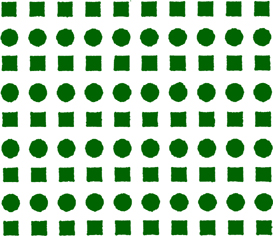
Once its pointed out that it can also be viewed as columns of alternate squares and circles, we, of course, see it. We have become habituated to passively organize similar items together in our minds. Geniuses, on the other hand, subvert habituation by actively looking for alternative ways to look at and think about things.
Richard Feynman proposed teaching productive thinking in our educational institutions in lieu of reproductive thinking. He believed that the successful user of mathematics is an inventor of new ways of thinking in given situations. Even if the old ways are well known, he thought it is usually better to invent your own way or a new way than it is to look up an old solution and apply what youve looked up.
For example, 29 + 3 is considered a third-grade problem, because it requires the advanced technique of carrying; yet Feynman pointed out that a first grader could handle it by thinking 30, 31, 32. Or a child could mark numbers on a line and count off the spacesa method that becomes useful in understanding measurements and fractions. One can write larger numbers in columns and carry sums larger than 10, or use fingers or algebra (2 times what plus 3 is 7?). He encouraged teaching people how to think about problems many different ways, using trial and error.
In contrast, reproductive thinking fosters rigidity of thought, which is why we so often fail when confronted with a new problem that is superficially similar to past experiences, but is different from previously encountered problems in its deep structure. Interpreting such a problem through the lens of past experience will, by definition, lead the thinker astray. Reproductive thinking leads us to the usual ideas and not to original ones. If you always think the way youve always thought, youll always get what youve always gotthe same old, same old ideas.


